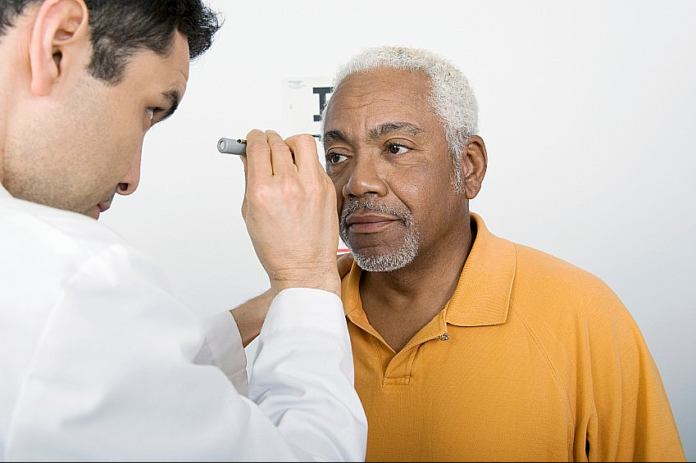Glaucoma is the leading cause of blindness in African Americans, and half of those with the condition are unaware they have it. Glaucoma strikes Blacks about ten years earlier and more quickly than in other populations, and if it runs in your family, your risk of getting it increases by 20 percent.
What is glaucoma?
Glaucoma is an eye condition that is relatively common. When the optic nerve, which connects the eye to the brain, becomes damaged, there is usually a fluid buildup in the front of the eye. The progressive damage causes increased pressure within the eyeball. This damage is recognized by a loss of optic nerve tissue in a pattern called cupping and by blind spots or blurry spots in the peripheral (side) vision. Advanced glaucoma can lead to permanently blurred, dimmed vision or even blindness.
Early and moderate-stage glaucoma generally has no symptoms. This is why it is important to be examined by an ophthalmologist (eye doctor) regularly to determine if you are likely to develop the disease.
Causes
Researchers don’t exactly know what causes glaucoma. Increased eye pressure is the likeliest culprit, which occurs when the eye’s clear fluid (aqueous humor) fails to drain properly.
However, glaucoma can also develop if the eye pressure is healthy. Currently, treatment for glaucoma is aimed at lowering your eye pressure, even if it is “normal.”
Even though scientists can’t concretely explain what causes glaucoma, there are risk factors for the condition:
- Old age
- Ethnicity (African Americans and Hispanics have the highest risk for developing it)
- Health conditions like diabetes, hypothyroidism, high blood pressure
- Eye Injuries
- Myopia (nearsightedness)
- Being on corticosteroids meds (like prednisone)
- A family history of eye disease
- A visually demanding job
- Taking a medication that has visual side effects
- Previous eye injuries or eye surgery
Glaucoma usually occurs in both eyes, although one eye may be more affected than the other.
Types
Primary Open Angle Glaucoma (POAG)
POAG is the most common type of glaucoma that occurs when the eye’s drainage canals become blocked, and the fluid accumulation causes pressure to build within the eye. Vision loss is usually slow, gradual, and often, there are no early warning signs. There is a strong genetic predisposition for this type of glaucoma.
Angle Closure Glaucoma (ACG)
ACG is less common than POAG, and this takes place when the eye’s clear fluid cannot drain properly because the entrance to the drainage canal is either too narrow or closed. In this case, eye pressure can rise very quickly and be triggered by pupil dilation. Symptoms can include sudden eye pain, nausea, headaches, and blurred vision. If you experience these symptoms, get to an eye doctor (opthalmologist) quickly.
Normal-Tension Glaucoma (NTG)
NTG is a low-pressure kind of glaucoma where the optic nerve is damaged, but the eye pressure is not extremely elevated. Genetics are to blame in NTG; a family history of glaucoma, cardiovascular disease, and Japanese ancestry are a few of the risk factors here.
Secondary Glaucomas (SG)
SG is just that and is brought on by other complications like eye injury, cataracts, diabetes, eye surgery, or eye tumors. In SG, damage to the fluid drainage canal is treated by meds or surgery.
Symptoms
Many glaucoma patients don’t always notice symptoms at the beginning stages of the condition until they have lost some of their side vision. Other glaucoma symptoms may include:
- Eye pain (severe eye pain should be treated by a doctor immediately)
- Eye redness
- Hazy vision
- Seeing halos around lights
- Narrowing of vision or tunnel vision
Tests
An eye care physician can detect glaucoma during a routine eye exam. Painless tests are given to patients to check for glaucoma, including vision tests and measurements of the pressure inside your eyes.
Treatments
There is no reversal for a glaucoma diagnosis. Although treatment varies for all individuals, the overall goal is to prevent further damage and sight loss from glaucoma. A physician will recommend a specific treatment based on the type of glaucoma a patient has:
- Eye drops will reduce eye pressure
- Laser treatment can open up blocked drainage tubes or reduce the production of eye fluid
- Surgery may improve the drainage of fluid
An opthalmologist will also recommend that you make regular appointments so that he can monitor your glaucoma and determine whether the treatment option is doing its job.
Take care of your eyes
Although much still needs to be learned about why African Americans are more at risk for glaucoma, one thing is certain, early diagnosis and treatment are key in preventing vision loss.
In order to maintain a lifetime of healthy vision, the American Optometric Association (AOA) recommends a comprehensive eye exam every two years for adults ages 18 to 60 and annual exams for seniors aged 61 and older. “At risk” adults should have more frequent exams.
Adults who wear contact lenses should have annual eye exams, according to the AOA.











